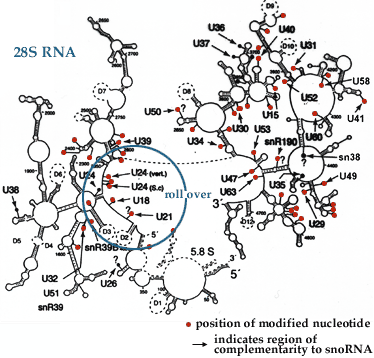|
snoRNA Maturation of eukaryotic
rRNA requires the action of a large population of
snoRNAs (small nucleolar RNAs) produced in the
nucleus (see snoRNA production). Some of the
snoRNAs function during the hydrolytic processing of
the primary transcript to the individual rRNA
species. However, the vast majority function by
guiding modification of individual nucleotides in the
rRNAs. rRNA contains two major types of nucleotide
modifications; pseudouridines (psi) and methylation
of the ribose, 2’-O-methylation. Mammalian rRNA
has more than 100 2’-O-methyl groups and
approximately 95 pseudouridines. These modifications
are inserted at precise locations in the rRNA. The
modification sites are identified by the snoRNAs
through base pairing between the snoRNA and sequences
around the specific modification site in the rRNA
(see roll over in figure below).
|
